The Supermicro SuperServer 5018D-LN4T is a great platform for firewalls and other network appliances. Over the past few months we have seen an explosion in updating the network edge with newer generation devices that enhance service delivery. The Supermicro SuperServer 5018D-LN4T combines four onboard network ports, and a dual core Broadwell-DE CPU into a compact, short depth rackmount chassis.
Test Configuration Overview
Our test configuration was similar to what one may configure in a network appliance:
- System: Supermicro SuperServer 5018D-LN4T
- Motherboard: Supermicro X10SDV-2C-TP4F
- CPU: Intel Pentium D1508
- Case: Supermicro CSE-504-203B
- RAM: 32GB DDR4 RDIMMs (4x 8GB)
- SSD: Toshiba THNSN5512GPU7GR 512GB PCIe
- HDD: WD RE 250GB
Overall, we felt that the platform was a good test case for the compact server. We might suggest using all-flash in deployments given the higher-reliability of those devices.
Supermicro SuperServer 5018D-LN4T Overview
The Supermicro SuperServer 5018D-LN4T is a 1U server with a short (9.8″) mounting depth. As such it can be mounted without requiring rails. It can also be mounted in short-depth 2 post telecom equipment racks. The compact platform is perfect for appliances that are at the network edge where racks can utilize only a small amount of space. The front of the server has basic LED indicator lights as well as power on/ reset switches.
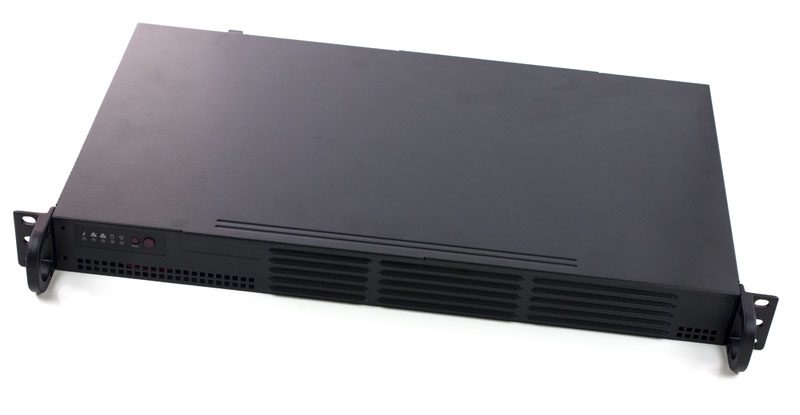
The rear I/O is where the server shines. There are a few unique features that make this an excellent networking platform. First, there are dual 1GbE network ports. These can be used as WAN/ modem uplink ports in many installations since today’s network speeds are often sub 1Gbps. For higher speed networking, there are dual 10GbE (SFP+) network ports. In higher bandwidth scenarios these can be used for WAN connections or 10Gb LAN connections.
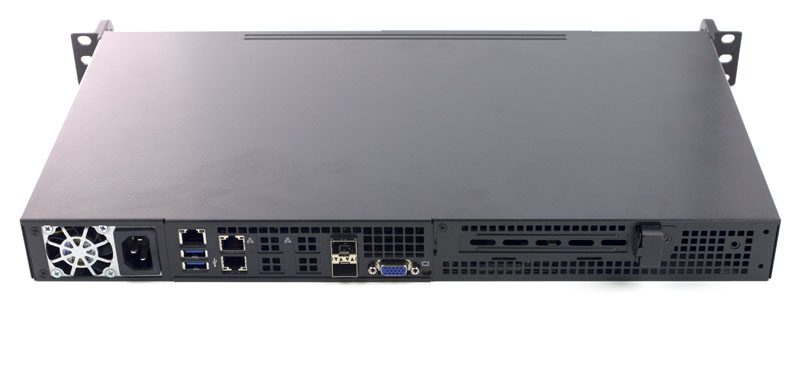
In addition to the network ports, there are two USB 3.0 ports and a legacy VGA port for local KVM capabilities. One can also see that this platform has an out-of-band network port. Unlike many serial console only appliances, the 5018D-LN4T has an out-of-band management port that can be used to access the management WebGUI, iKVM functionality or serial-over-LAN (SoL) features. We strongly prefer this management option over traditional serial-only consoles as it makes remote management seamless.
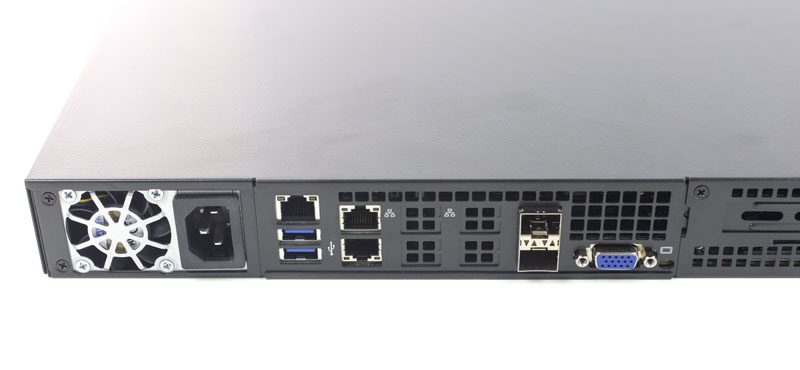
Inside the server we can see a Supermicro X10SDV FlexATX layout motherboard, the X10SDV-2C-TP4F. The motherboard features an onboard Intel Pentium D1508 which is a dual core, four thread processor. With 3MB L3 cache and a 2.2GHz base clock (2.6GHz turbo) the processor is essentially half of the Intel Xeon D-1518, yet with higher maximum clock speeds. Here is a link to the specs comparison via Intel ARK. The Intel Pentium D1508 is a 25W TDP CPU and that includes both the platform controller hub and 10GbE MAC on the SoC. Given the use of the Broadwell-DE platform, the system can handle up to four DDR4 RDIMMs for up to 128GB of 1866MHz RAM.
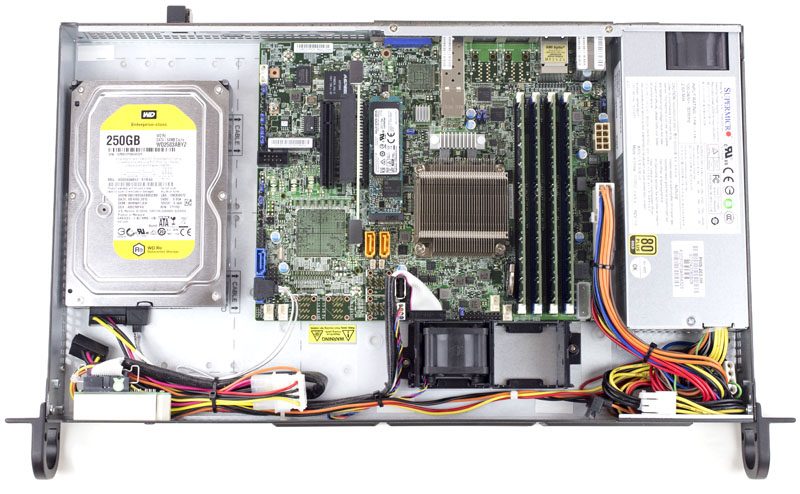
The expansion capabilities of the Supermicro SuperServer 5018D-LN4T are excellent, even given the small internal space. There is one usable riser card slot that can be used for a PCIe 3.0 add-in card. Supermicro pictures the server with a quad port 1GbE NIC. Given the single cooling fan, we would suggest a second fan be added if one were trying to use a much warmer PCIe card.
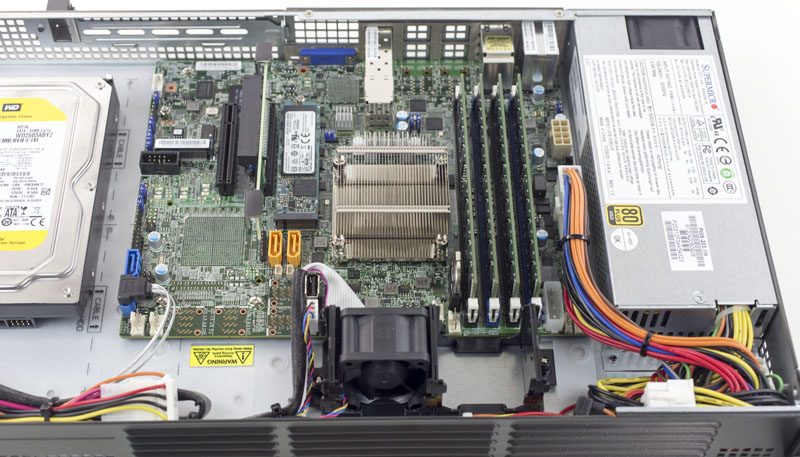
Beyond this there are two SATA DOM ports for embedded storage. These SATA DOM ports can supply power to the modules without using a separate cable. There are two additional SATA III 6.0Gbps ports for storage. Finally there is a m.2 slot that can handle m.2 PCIe SSDs. Finally, there is a mSATA port which can be used as another embedded SSD option. Overall, there are many options and one could potentially have 6x SSDs in the compact system.
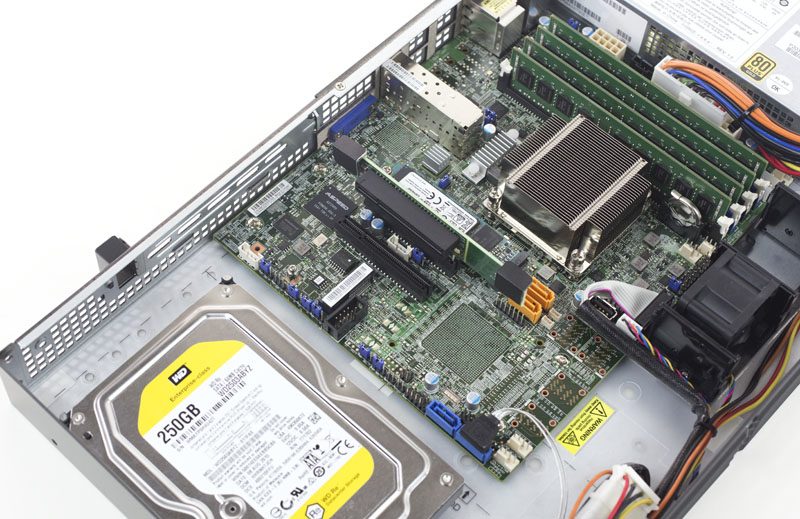
Inside the server there is a 200W 80Plus Gold power supply which is plenty for such a low power platform. With the internal PSU, one can simply utilize a standard power cable and there is no external power brick required. This keeps rack cabling clean.
Supermicro Remote Management
Supermicro’s IPMI and KVM-over-IP as described a few times on this site, allows for a lot of deployment flexibility. Things such as fan speeds, chassis intrusion sensors, thermal sensors, and etc. can be monitored remotely. Alerts can be setup to notify the admins of issues. Beyond this, the functionality also allows for remote power control. One can do remote power up, power down, and reset of the server in the event that it becomes unresponsive.
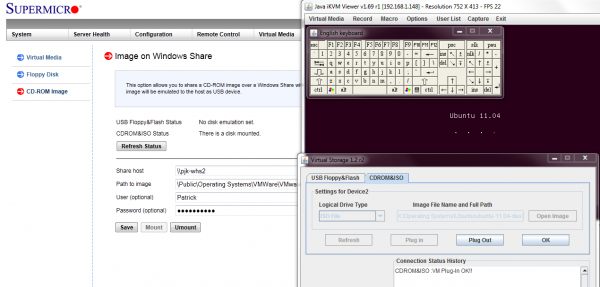
Another important feature is the ability to remotely mount CD images and floppy images to the machine over the dedicated management Ethernet controller. This keeps maintenance traffic off of the primary Intel NICs. At the same time it removes the need for an optical disk to be connected to the Supermicro motherboard.
The latest revision of Supermicro’s BIOS has a great feature: the BMC IP address shows up on the post screen! This is a super feature because if one has a KVM cart hooked up to the system, it gives an indicator of which machine one is connected to during post.

Supermicro does include KVM-over-IP functionality with the motherboard. We have been testing servers from HPE, Dell, Lenovo and Intel that all required an additional add-in key to get this functionality. It is an absolute time and money saver in the datacenter and other vendors should follow Supermicro’s lead in this space.
New in this iteration is the addition of a HTML5 iKVM viewer. Traditional iKVM applications have been Java-based which created compatibility issues for some users. The new Supermicro HTML5 iKVM works with browsers such as Chrome and Microsoft Edge and does not require Java to run. The Supermicro SuperServer 5018D-LN4T was our first system from Supermicro with this feature.

Power Consumption and Performance
In terms of power consumption, network appliances aim to sip power. We found
- Power off BMC only: 4.7w
- Idle Ubuntu: 25.1W
- Maximum observed: 45.8W
One can see raw CPU performance figures of the platform at Linux-Bench. Overall performance was better than half of the Intel Xeon D-1518, likely due to the Turbo speeds being accessible on the Pentium D1508.
With the onboard Toshiba THNSN5512GPU7GR 512GB NVMe SSD one can get signficantly more storage performance than with traditional SATA SSDs. The onboard m.2 slot allows the use of a NVMe SSD without utilizing the add-in card slot. We did get to run a quick benchmark of the drive to illustrate this:
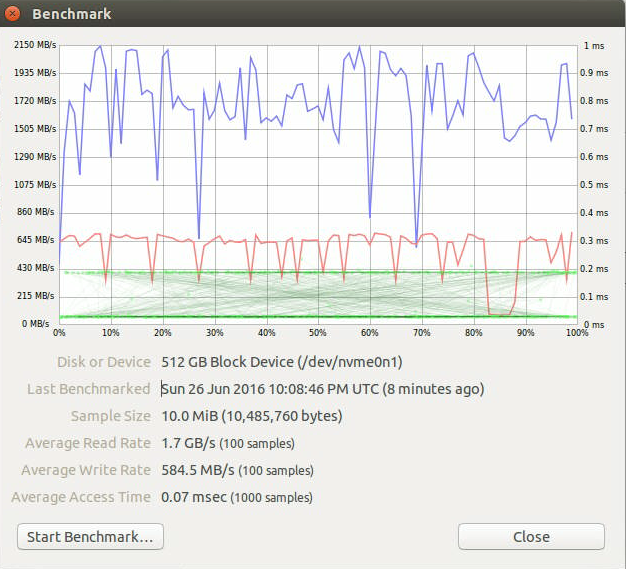
Even at a relatively low queue depth, the Supermicro server with the Toshiba THNSN5512GPU7GR 512GB NVMe SSD was able to push over three times the read speed of traditional SATA SSDs and approximately ten times the read speed of traditional hard drives. If one is caching data at the network edge, this is a great configuration option.
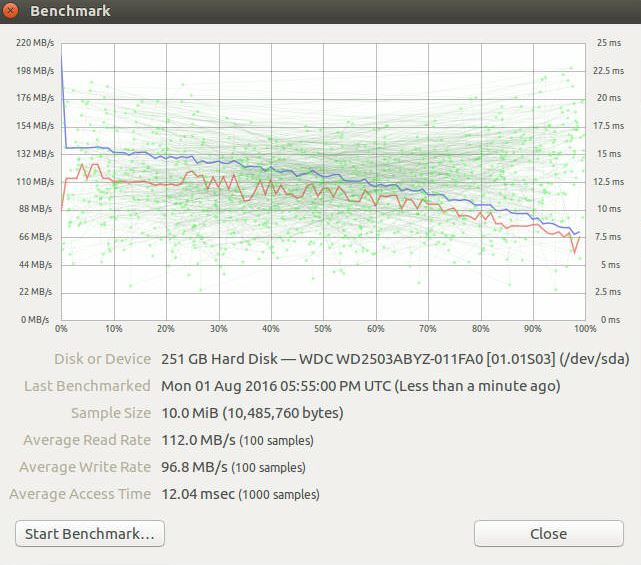
As this is a network appliance oriented platform, we used iperf3 to measure network speeds across all four interfaces. We present our results in MB/s (bytes not bits) since that allows an easy translation to many of the other subsystem figures.
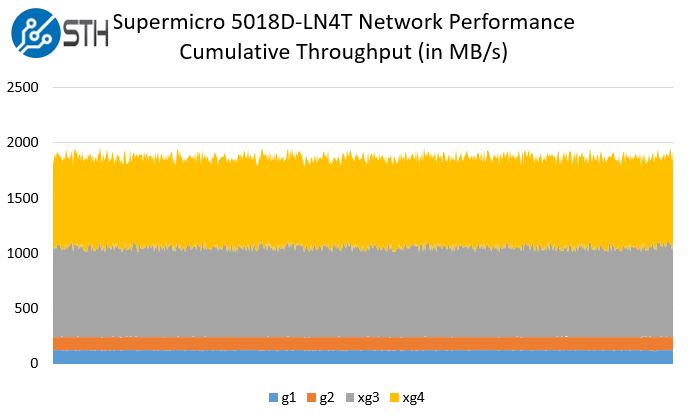
Here the network performance of 22Gbps across the four NICs averages around 1.9GB/s in aggregate network performance. If one compares this to the simple NVMe testing, one can see why the inclusion of a m.2 slot for a PCIe/ NVMe drive is very attractive. Even in the short depth chassis, Supermicro’s low power platform has the CPU, networking and storage performance to excel in many applications.
Final Words
Overall the performance of the platform is well-balanced. With the speed bump up to 10Gbps networking, the Intel Pentium D1508 becomes a solid choice over the lower-end Intel Atom line. The Supermicro SYS-5018D-LN4T delivers a multitude of storage and networking options to create a customizable platform capable of being compact, low power and fast. If one is building a low-power network appliance, the Supermicro SYS-5018D-LN4T is worth consideration.
Want to try this system?
Do you want to try this system? We will have a configuration in the DemoEval lab for a short period of time starting next week. Run your own workloads on this platform.

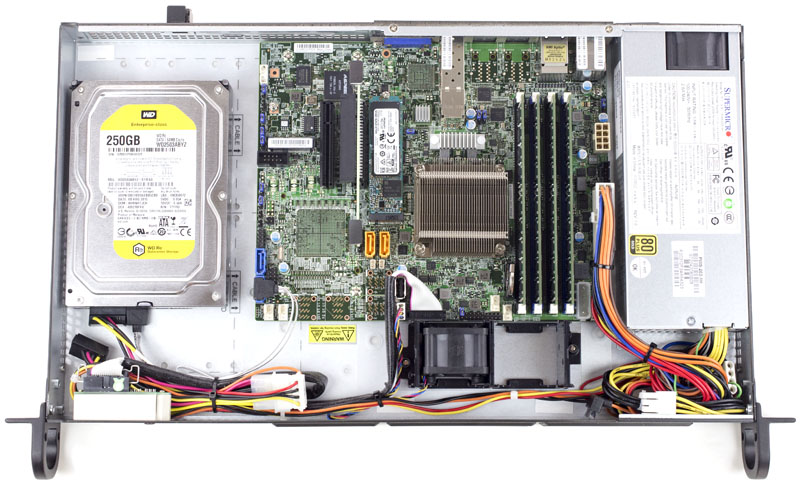




No price given??